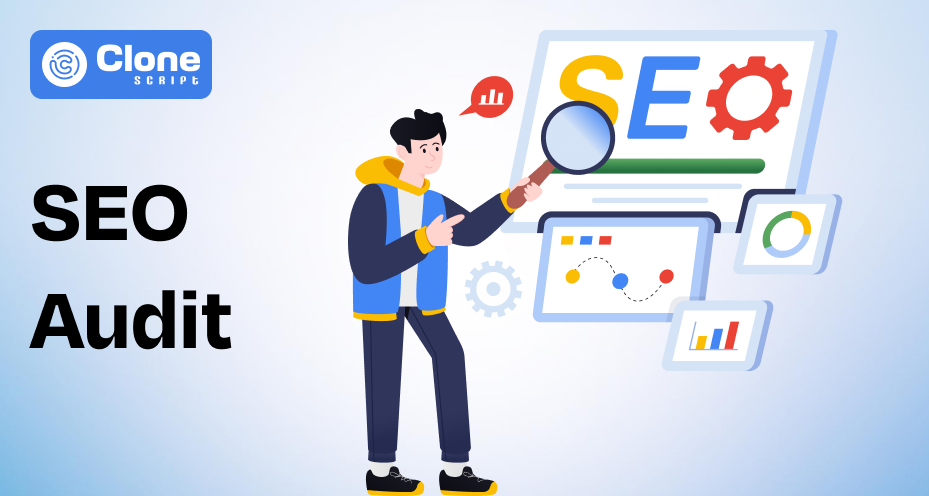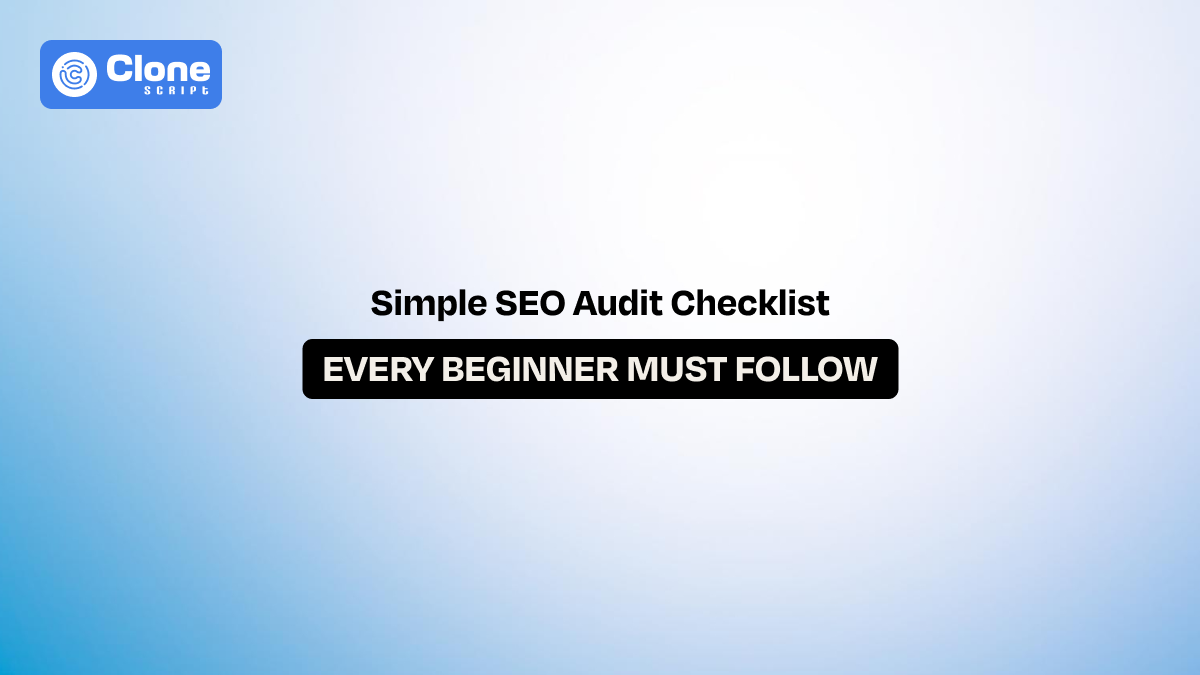Website SEO Audit Checklist Every Beginner Must Follow Right Now
Nowadays, Search Engine Optimization (SEO) plus Ask Engine Optimization (AEO) has become important. Why? Every business website tends to rank on the 1st page of search results. But what is the best way to appear there? Only an SEO audit can be helpful.
One thing to keep in mind: It doesn’t matter how premium your site is or what advanced features the user has.
The thing is, the website has to be optimized well for search engines and, of course, the searchers, too.
This guide walks you through an SEO audit checklist designed for beginners. Each section highlights what to look for when finding the site on search results, along with AI summaries. You’ll also find free tools to help you get started and practical steps you can apply immediately. Think of it as a roadmap to make your website not just functional, but truly discoverable.
What is an SEO Audit?
In simple terms, an SEO audit is a set of practices for evaluating how well a website aligns with search engine ranking factors. Just like a health check-up identifies areas where lifestyle improvements are needed, an audit uncovers the technical, structural, and content-related issues that prevent a website from reaching its full potential.
For beginners, it’s helpful to think of an audit as a diagnostic process.
Search engines use hundreds of signals to decide which websites appear on the first page, and if any of those signals are weak, such as slow loading speed, broken links, thin content, or poor mobile usability, rankings will suffer. An SEO audit brings these weaknesses to the surface so they can be corrected.
A complete audit typically examines:
-
On-page SEO factors: keywords, meta tags, headings, and content optimization.
-
Technical elements: site structure, crawlability, indexation, and page speed.
-
Content performance: relevance, depth, and value for the target audience.
-
Backlink profile: quality and authority of external links.
-
User experience: ease of navigation, mobile-friendliness, and engagement.
An SEO audit helps beginners answer one critical question: “Is my website built in a way that both users and search engines can easily understand and trust?”
Why Do You Need an SEO Audit for a Website?
There are three primary reasons suggesting that a website audit for search engines is preferred:
-
Getting visible: To appear for every possible query searched by users on Google.
-
Identified gaps: Through competitor analysis, you can recognize missed opportunities in content creation, keyword mapping, and backlinks.
-
User experience measurement: By knowing why the site loads slowly and the menubar is stuck in iOS and Android devices, it helps to manage UX and improve core web vitals.
An SEO audit isn’t just a box to check. It’s a strategic foundation for growing organic visibility. In 2025, search continues to drive the majority of site traffic, and strong rankings make a meaningful difference.
-
Over 53% of all website traffic now comes from organic search, underscoring the central role it plays in getting noticed online.
-
A staggering 99% of users never click past the first page of search results. If a site isn’t optimized, it effectively vanishes.
-
The #1 result on Google captures around 27–28% of all clicks, while positions two and three fall sharply in visibility.
Beyond traditional SEO, evolving search behaviors are reshaping strategies:
-
AI-powered search and answer-driven formats are shifting user behavior. Now, 80% of users complete 40% of searches without clicking any links, relying on AI summaries.
That means a website must be optimized not only for ranking but also for feeding data into AI engines, a key reason an audit is more critical than ever.
Putting it together, an audit helps:
-
Reveal obstacles: To identify hidden issues like slow load time, crawl errors, or thin content.
-
Align with modern search trends: This ensures visibility in both traditional and AI-driven environments.
-
Secure traffic share: Only through optimization can a site compete for that top 1% visibility.
For those just starting, this becomes a guiding map. Highlighting what matters most, where to act first, and how to build a website that performs and stands out.
It’s a moment to know the checklist for measuring where your site needs to be optimized and what needs to be changed.
Simple SEO Audit Checklist for Beginners
Auditing a website for the first time can feel overwhelming. But the truth is, every website, whether a blog, e-commerce store, or small business site, relies on the same foundational principles. By understanding the process into manageable sections, anyone (even without deep SEO experience) can uncover what’s holding a site back and where growth opportunities lie.
1. On-Page SEO Audit
On-page SEO is about refining the elements you directly control on your website. Think of it as making your content and structure easy for both search engines and humans to understand.
What to optimize:
-
Title Tags & Meta Descriptions: Each page should have a distinct, keyword-rich title and a compelling description that improves CTR.
-
Headings (H1–H3): Structured headings not only guide readers but also signal topical hierarchy to crawlers.
-
Keyword Placement: Keywords should appear naturally in important places (title, first 100 words, headings) without stuffing.
-
Internal Linking: Link to related articles and cornerstone pages to pass authority and reduce orphan pages.
-
Image Optimization: Use descriptive alt text and compress images for speed.
Beginner Guidance: If you’re new, start by auditing 3–5 of your most important pages first. Small improvements in these key areas yield visible ranking boosts.
Extra Insight: According to Ahrefs (2025), over 60% of sites audited had duplicate or missing meta descriptions, which directly affects click-through rates. Fixing these simple elements can give beginners a quick win in SEO.
2. Technical SEO Audit
Even the best content won’t rank if search engines can’t properly access or index it. A technical audit ensures your foundation is strong.
What to optimize:
-
Site Speed: Use Google PageSpeed Insights to test load times; aim for under 2.5 seconds.
-
Mobile-Friendliness: Responsive design is a ranking factor under mobile-first indexing.
-
Crawlability & Indexing: Review your robots.txt and XML sitemap to make sure no key pages are blocked.
-
HTTPS Security: SSL certificates are now a trust signal; sites without HTTPS lose rankings.
-
Broken Links & Redirects: Identify 404s or misdirected links that frustrate users and search engines.
Beginner Guidance: Use Google Search Console as your first tool. It shows errors Google sees, including crawl issues and mobile usability problems.
Extra Insight: Studies show that improving Core Web Vitals can not only improve rankings but also reduce bounce rates by up to 24%. For small businesses, even shaving one second off load times can increase conversions by 7% (Google/ThinkWithGoogle, 2025).
3. Content Audit
Content is where most websites either rank or struggle. A content audit reviews both quality and relevance. After all, content is the king, and from there, your brand perception has been built.
What to optimize:
-
Thin or Duplicate Content: Remove or merge pages with little unique value. Try to offer a solution to the user rather than promoting a service or product.
-
Keyword Relevance: Each page should target specific keywords aligned with search intent.
-
Readability & Flow: Ensure clarity and engagement; aim for a Flesch reading score of 60–70.
-
Freshness: Update old posts with new data, examples, or visuals.
Beginner Guidance: Focus on one type of content first (e.g., blogs or product pages). Updating older pages is easier than creating new ones and can drive quick SEO gains.
Extra Insight: HubSpot (2025) reports that websites that regularly update content generate 67% more leads than those that don’t. For beginners, refreshing even 3–4 outdated blog posts can bring noticeable traffic growth.
If you don’t have an in-house team of web copywriters and professional blog writers, then hire and outsource them through a freelancing platform or other individual marketing agencies. Read reviews and service outcomes that look reliable for your business.
4. Backlink Audit
Backlinks are one of Google’s strongest ranking signals, but not all links are beneficial. A backlink audit highlights what’s helping or hurting your website authority.
What to optimize:
-
Identify Toxic Links: Disavow links from spammy or irrelevant sites. A low-quality link to your site is considered a red flag and creates the chance of an implicit penalty from search engines.
-
Link Diversity: A healthy profile includes blogs, news mentions, forums, and niche directories. In terms of building backlinks, quantity doesn’t matter, but quality does. Getting tens of links from the same site will not work, but acquiring a recommendation from different sites will.
-
Competitor Benchmarking: See who’s linking to your competitors but not to you. This creates a clear picture of where you are standing compared to your competition.
Beginner Guidance: Don’t chase hundreds of links at once. Instead, focus on getting a few high-quality and relevant backlinks. Guest posts or partnerships in your niche are a great start.
Extra Insight: Research from Backlinko shows that the #1 page on Google has an average of 3.8x more backlinks than pages ranking #2–10. For beginners, this proves that quality matters more than sheer quantity.
5. User Experience (UX) Audit
Don’t think that search engines consider the website user experience at all.
Google interprets your site as reputable because users spend more time and take preferred actions like purchasing, booking a call, etc. These are signs of good UX optimization.
What to optimize:
-
Navigation Simplicity: Make menus and site structure easy to follow. Don’t confuse the site navigation, especially on mobile.
-
Core Web Vitals: Optimize website for metrics like Largest Contentful Paint (LCP) and CLS. If you find any other issues regarding loading speed and padding, then correct them.
-
Mobile Responsiveness: Buttons, text, and forms should work seamlessly across devices. Check the landing page optimized for Android and iOS without affecting the overall look.
-
Engagement Signals: Analyze bounce rate, time on site, and conversion paths. If the numbers are not satisfactory, identify why it’s going wrong through the poor homepage button placement or checkout.
Beginner Guidance: A confusing layout can undo all other SEO efforts. Test your site yourself. If navigation feels clunky, users likely feel the same.
Extra Insight: A 2025 Nielsen Norman study found that 88% of users won’t return after a poor UX. Even minor improvements, like simplifying forms or making CTAs clearer, can significantly improve SEO performance.
Free Tools You Can Use for an SEO Audit
An SEO audit doesn’t require a big budget. Many powerful free tools can give beginners the same level of insights that professionals use daily. These tools cover different areas of SEO, technical performance, content quality, backlinks, and user experience. Using a mix of them provides a well-rounded picture.
Here are the top options worth exploring:
-
Google Search Console – Reveals how Google views your site. It reports indexing status, crawl errors, and search queries driving traffic. Beginners should focus on the Performance and Coverage reports.
-
Google Analytics – Tracks user interactions like bounce rate, time on page, and conversions. Understanding this data helps identify content that keeps visitors engaged versus pages that need improvement.
-
PageSpeed Insights – Analyzes page loading speed and suggests fixes like image compression or script optimization. Since speed is both a ranking factor and a user experience issue, this tool is indispensable.
-
Screaming Frog (Free Version) – Crawls up to 500 URLs, highlighting broken links, duplicate content, redirect chains, and missing meta tags. A great way to spot structural SEO issues quickly.
-
Ahrefs Webmaster Tools (Free) – Offers free site audits and backlink analysis. Beginners can track referring domains, spot toxic links, and see which keywords pages already rank for.
-
Ubersuggest (Free Tier) – Useful for keyword insights, content ideas, and basic site audits. It’s beginner-friendly and helps connect SEO fixes with keyword opportunities.
-
AnswerThePublic (Freemium) – Not an audit tool in the strict sense, but excellent for discovering what real users search for. It helps improve content relevance, which is part of a good content audit.
-
GTmetrix – Another free speed analysis tool, offering deeper insights into performance metrics like Time to First Byte (TTFB) and waterfall breakdowns. Perfect for diagnosing hidden speed bottlenecks.
-
SEO Minion (Free Chrome Extension) – Handy for quick on-page checks. It reviews meta tags, headings, and internal links directly while browsing a page.
Quick Insight: According to a 2025 SEMrush survey, 67% of small businesses rely on free SEO tools before investing in premium ones. For beginners, these free resources provide more than enough to conduct a complete website audit.
Conclusion
A well-structured SEO audit is more than a technical routine. It’s the foundation of long-term online growth. By following a simple SEO audit checklist, beginners can uncover hidden issues, improve on-page elements, strengthen backlinks, and enhance user experience. Free tools make this process accessible, while professional support ensures no detail is overlooked.
For businesses aiming to boost traffic, domain authority, and rankings, services like AllClone Script’s SEO audit can provide the extra edge. Remember, search engines reward well-optimized websites. Take the first step toward stronger visibility.

Get Professional SEO Audit Service
FAQs
-
What is an SEO audit checklist?
An SEO audit checklist is a step-by-step guide to reviewing a website’s health across on-page SEO, technical SEO, content, backlinks, and user experience. It helps beginners identify common SEO issues and provides a roadmap for fixes.
-
How often should I do a website SEO audit?
For beginners, a full audit every 3–6 months is recommended. However, critical checks like page speed, indexing errors, or broken links should be monitored monthly with free SEO audit tools.
-
How do I perform an SEO audit step by step?
To perform an SEO audit, follow these steps:
-
Check site indexing in Google Search Console.
-
Review page titles, meta descriptions, and headings.
-
Test site speed with PageSpeed Insights.
-
Run a mobile-friendly test.
-
Audit content for keywords, duplication, and freshness.
-
Analyze backlinks with Ahrefs Webmaster Tools or Ubersuggest.
-
Improve navigation and user engagement metrics.
In this way, you can complete a website audit.
-
Can I do an SEO audit without technical knowledge?
Yes. Most free SEO tools provide beginner-friendly reports that highlight issues in plain language. Even without coding knowledge, you can fix basic on-page issues, improve speed, and clean up content. For complex technical SEO, professional support may be needed.
-
Do small businesses need SEO audit services?
Yes. Small businesses face limited visibility and high competition online. A proper audit helps them identify weaknesses, prioritize fixes, and compete with bigger brands effectively.
-
How does an SEO audit improve website traffic?
An audit uncovers hidden issues that hurt visibility. Fixing them helps search engines crawl and index your pages better, improves user experience, and strengthens your content strategy. It results in higher rankings and more traffic.
 BTC - Bitcoin
BTC - Bitcoin
 USDTERC20 - USDT ERC20
USDTERC20 - USDT ERC20
 ETH - Ethereum
ETH - Ethereum
 BNB - Binance
BNB - Binance
 BCH - Bitcoin Cash
BCH - Bitcoin Cash
 DOGE - Dogecoin
DOGE - Dogecoin
 TRX - TRON
TRX - TRON
 USDTTRC20 - USD TRC20
USDTTRC20 - USD TRC20
 LTC - LiteCoin
LTC - LiteCoin







